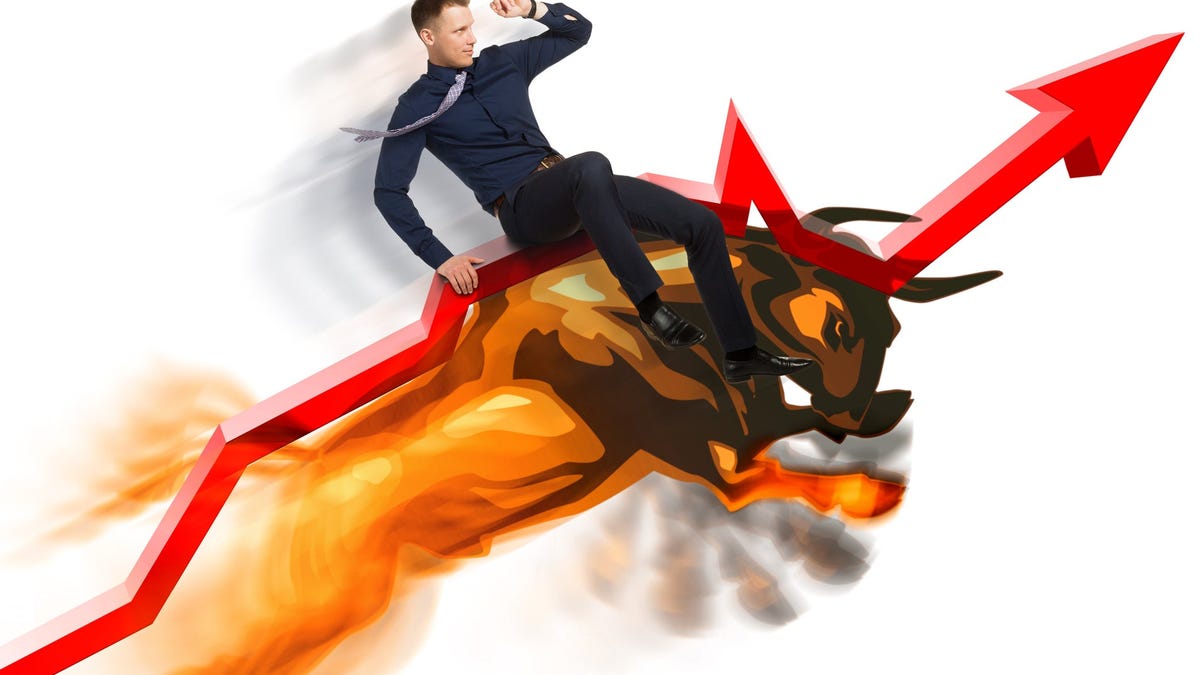INTERNET MARKETING NEWS
Will the stock market take a breather? Here’s what the second half of 2021 could look like for your retirement investments
Joseph Gillis Jr. is nearing retirement and has piled money into his nest egg during the pandemic. But he is concerned about two things: how climbing prices and a potential rise in corporate taxes could chip away at his investments. “It’s a mental struggle. My wife and I want to save enough so we can retire and be somewhat healthy and enjoy it,” says Gillis, 58, who is a manager of analytics at Tufts Medical Center. “But we also want to continue to see our savings grow.”Gillis and his wife, who live in Bridgewater, Massachusetts, weren’t spending money dining out or going on vacation the past year. So they socked their stimulus checks and extra savings into their retirement accounts and scooped up shares of Disney, Coke and Hershey in hopes that those companies were diversified enough to come out stronger on the other side of COVID, he said.He also likes to invest in stocks like those since they typically provide dividends for retirement income.Why can’t companies find workers: Spurred by COVID-19, many Americans are launching their own businessesCryptos are now in 401(ks): But are they the right investment for your nest egg?Gillis is relying on a self-funded retirement. He and his wife are still aggressively investing in stocks, even though bonds have typically been a safe choice in the later stages of retirement investing and have historically paid a higher level of income than stocks.But bonds haven’t delivered strong returns for years and yields are nowhere close to compensating investors for future inflation.”With inflation going up, that means I need more money put aside because I just lost some of my buying power,” says Gillis. “If companies are also paying more in taxes, that’s less growth and dividends being kicked off, which is an important part of retirement plans.” Where’s the stock market headed?Employees like Gillis want to know where the stock market is headed for the remainder of the year and how much further their retirement accounts could grow after the stock market rebounded from the worst global pandemic in a century and one of the sharpest downturns since the Great Depression.The U.S. economy is poised to benefit from a summer spending boom as businesses reopen, fueled by reduced coronavirus fears, steady household incomes and padded savings accounts. As the economy recovers and more Americans are vaccinated, this bull-market run has more room to run and could further add to the value of Americans’ 401(k) plans, if history is any indication. Stocks have historically risen 85% of the time on a one-year basis during expansionary periods. And going back to 1957, the average bull market in the S&P 500 has lasted 5.8 years, according to Truist Wealth, a wealth management firm.That suggests the stock market is likely poised to keep climbing in the second half of 2021 and beyond as the economy recovers. Propelling that expansion are a strong housing market, robust spending, better-than-expected corporate profits, a healing jobs market and unprecedented policy support from Washington and the Federal Reserve.The S&P 500 has advanced more than 80% since hitting a low in March 2020 following a pandemic-driven sell-off. But now, in the second year of the bull market, things could turn bumpy over the next six months as the market reacts to tensions between better economic and corporate earnings growth and the worries about higher taxes and rising interest rates, analysts say. “Stocks typically lead the economy and see better times ahead during the first year of a bull market,” says Ryan Detrick, chief market strategist at LPL Financial. “Then, when the better times come after a recession, stocks can sometimes catch their breath.”The second year of a bull marketThe second year of a bull market tends to be choppier, with positive but moderating returns and periodic pullbacks.Going back to 1957, the average return in the first year of a bull market is 43.3%, compared with 13.3% in the second year, according to Truist Wealth.“It’s ironic, but the second year isn’t as strong because the market had already been looking forward to those better prospects,” says Keith Lerner, chief market strategist at Truist Wealth.There are similarities now with 2004 and 2010, the second years of those bull markets, Lerner says. After large initial snapback rallies, those markets moved to a choppier phase.But those prior bull markets still had several years of growth left. To be sure, the stock market hasn’t seen a 5% decline since last fall, which is one of the longer streaks without one over the past decade, analysts say. Stock markets on average experience about three 5%-plus falls a year. That makes the market more vulnerable in the near term following some signs of investor complacency, analysts say. Still, the average bull market has averaged a gain of about 179% compared with 89% currently, Lerner said. While bull market returns tend to be front-end loaded toward the beginning of a run, more upside likely remains, he added.How could rising prices affect your 401(k)?Rising prices won’t just weigh on your travel budget or your shopping bills. It could also affect your investments. That’s because a longer bout of rising inflation could force the Federal Reserve to hike interest rates sooner than expected, which would push up borrowing costs for consumer loans like mortgages. Data released last week showed consumer prices spiked 5% over the last year as of May, the biggest 12-month inflation surge since 2008.When stripping out the volatile food and energy components, core inflation rose 0.7% in May and has jumped 3.8% over the past year. That’s the biggest 12-month jump in core inflation since 1992.That’s spooked some Americans who wonder whether this is a blip or a return to the hyperinflation economy of the 1970s. But the jump in prices is widely viewed by economists as temporary.Because events in the economy are now compared with a year ago, when everything was largely shut down, growth and inflation rates are set to appear exaggerated as the recovery accelerates, economists say. The unprecedented nature of the pandemic, along with the subsequent stimulus and vaccinations, make forecasting more challenging, they say. Economists have argued that the leap in prices is a byproduct of a reopening economy and should abate by next year.Are rising prices going to hurt your investments?: Here’s how to protect your nest egg.Rising inflation impacts the stock market and more. Here’s how.Rising prices are scaring investors. Here’s how inflation works, how it affects investments like stocks and funds and how to protect your money.USA TODAYBut investors are unlikely to have a clear view of where inflation is headed for several months, which could make stock markets jittery, analysts say.That said, many of the forces that have kept a lid on inflation for more than a decade remain in place, including technological innovation, globalization and increased productivity.If you’re looking for clues on where the market thinks inflation is going, Detrick suggests monitoring the yield on the 10-year Treasury note, which currently stands around 1.45%. That yield influences borrowing costs on everything from mortgages to auto loans.Rising bond yields typically signal that investors are hopeful for more economic growth in the future. But they can also indicate a potential spike in inflation.Bond market investors are betting that there won’t be a significant rise in inflation since the yield on the 10-year Treasury isn’t surging and still sits below 1.5%, according to Detrick.”All the talk about inflation is out there and the economic data is hot,” says Detrick. “But the bond market isn’t worried about inflation.”Policy shifts may challenge marketsTo fund President Joe Biden’s “Build Back Better” agenda, which includes his infrastructure plan, the White House has proposed boosting the corporate tax rate to 28% from 21%.Biden is also calling on Congress to raise taxes on wealthy Americans for the first time in nearly a decade to help pay for his plan to provide relief to families and reshape the U.S. economy. It would nearly double the capital gains tax — the tax on investment profits — to 39.6% for people earning more than $1 million a year. The current rate is 20%.So how has the market been affected by corporate tax increases in the past? Stocks have historically reacted to higher corporate tax rates with below-average returns. Going back to 1940, the S&P 500 has posted a return of 4.2% on average in the 12 months after the corporate tax rate was increased, according to LPL Financial.Corporate profits will likely take a hit since the stock market is driven in part by earnings growth, analysts say. Still, markets so far have taken the proposed tax changes in stride, largely due to expectations that they will be reduced during negotiations and the economy will be strong enough to absorb the impact.If history holds true, tax increases may slow markets, but they shouldn’t fundamentally shift the return outlook as U.S. businesses remain agile, Detrick says.Hedge funds, short selling, short squeeze, explainedFirst GameStop, then silver. Reddit users are putting hedge funds to the test, one short squeeze at a time. Here’s what you need to know.Just the FAQs, USA TODAYWhat parts of the market will be hot or stagnate?Investors are shifting their money from growth stocks like technology companies, which thrived in a stay-at-home economy, and have opted instead for companies poised to benefit from lockdowns ending. That includes value stocks, which trade at low prices compared with their net worth.The shift in bets marks a reversal of a trend that has held since the global financial crisis in 2008, where growth stocks outpaced value stocks.Detrick, who favored growth stocks last year, now prefers value stocks for the remainder of 2021. That’s because early in an economic cycle, value stocks tend to perform better. Those stocks include companies that operate in energy, industry and banking, he says. “When you have an economy that’s really kicking into gear … with a lot of explosive growth, cyclical value areas tend to do better,” Detrick says.A potential rise in interest rates has implications for the stock market and could make shares of companies with relatively high prices less attractive. Those types of stocks tend to be technology companies that are priced for growth and not for a steady return of dividends like consumer staples, utilities and real estate companies.Rising rates tend to boost companies whose businesses and stock prices typically follow an upswing in the economy. Those include companies in the areas of energy, banking and industry.Bank stocks, which were hurt by lower interest rates last year, would see higher profits if rates keep rising. And while the technology sector would be at risk for declines if yields rose due to higher inflation, the sector’s rising free cash flow and recurring revenue streams would provide protection, experts say.There has also been a surge in the popularity of “meme stocks” like GameStop and AMC amid a boom in non-professional trading during the pandemic as more people work online. Those same factors spurred interest in “meme coins” like Dogecoin. Lerner, however, has advised investors to stay away from them due to their wild swings. “There’s a fear of missing out when people around you are making easy money, but when meme stocks drop, they can come down quickly,” Lerner says. “We also saw that with cryptocurrencies. For investors who want to speculate, don’t put more money in than you want to lose.”Follow Jessica Menton on Twitter @JessicaMenton.
Source link













